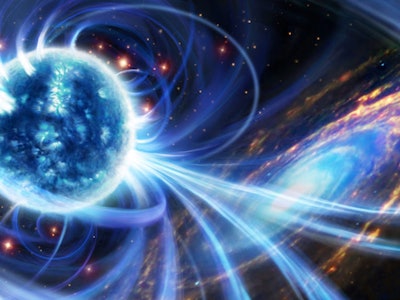New fast radio burst scrambles what we knew about their cause
A galaxy of old stars could tell a new tale.

Scientists traced a mysterious fast radio burst (FRB) to a strange location: a galaxy filled with old stars, instead of the zones of young stars where such events were found before.
The high-resolution view of the extremely energetic flash could provide more insights as to where these FRBs arise, astronomers said in two papers about the finding. It took 12 radio telescopes working in tandem to accomplish the research, illustrating the complexity of the search and the sensitivity required to catch one of these fleeting objects swiftly.
The results were published in Nature.
What’s new — Astronomers pinpointed the flash within a set of old stars, called a globular cluster, in the galaxy M81. The galaxy is well-known to amateur astronomers because it is so bright and relatively close, being only 12 million light-years away from Earth. But the burst’s location was a surprise finding, as all previous FRBs were found in zones with young stars.
The astronomers were forced to dig further for the source, as it “had to be something else” besides the old stars present in M81, said lead author Franz Kirsten in a statement. Kirsten has associations with the Netherlands Institute for Radio Astronomy and Chalmers University in Sweden.
A likely suspect for the FRB, the team said, arises from an event involving a stellar corpse called a white dwarf. White dwarves are formed when low- to medium-mass stars like our Sun shed their layers late in their lifetime as the stars run out of elements to fuse. A cooling star core, known as a white dwarf, is left behind.
FRBs may occur in binary stars that include a white dwarf and another star that has not yet ended its normal burning cycle. It’s possible that the white dwarf’s gravity may pull so much mass off its companion that the dwarf collapses under the weight of the accumulated gas into a kind of super-dense city-sized star, known as a neutron star.
In fact, the neutron star would need to have an ultra-strong magnetic field to accomplish the flashing feat, so astronomers are looking for a subset of neutron stars known as magnetars.
"This is a rare occurrence, but in a cluster of ancient stars, it is the simplest way of making fast radio bursts," Mohit Bhardwaj, a Ph.D. physics candidate at Canada’s McGill University in Canada who worked with Kirsten, said in the same statement.
Fast radio bursts are so named because of their millisecond scale intense flashes. This illustration shows the “brightness” as it increases in those few moments.
Here’s the background — This most recent FRB event — called FRB 20200120E — shows the complexity of understanding and tracing these energetic and brief explosions, which were first discovered in 2007. Only radio telescopes can spot the bursts, which last a mere thousandth of a second. While hundreds of flashes happen in the sky every day, only a few telescopes have been quick enough to observe an FRB in action.
FRB 20200120E had another surprise for investigators. Some of the observed flashes happened in only tens of nanoseconds, which was enough of a finding to generate a second paper in Nature Astronomy.
"That [flickering frequency] means they must have come from a tiny volume in space, smaller than a football field and perhaps only tens of metres across," lead author Kenzie Nimmo, who is with the University of Amsterdam and the Netherlands Institute for Radio Astronomy, said in the same statement.
What’s next — It will take more observations of M81’s globular cluster to figure out where the FRB might have arisen, whether from the magnetar or from another exotic object. Other possible candidates could be a black hole lurking nearby a massive star, or a rapidly rotating neutron star known as a pulsar.
While most FRBs found to date have been quite distant, a 2020 event within the Milky Way also has been helpful in learning more about how they work. The leading candidate for that event, which was only 30,000 light-years from Earth, is also a magnetar.
Abstract — Fast radio bursts (FRBs) are flashes of unknown physical origin1. The majority of FRBs have been seen only once, although some are known to generate multiple flashes2,3. Many models invoke magnetically powered neutron stars (magnetars) as the source of the emission4,5. Recently, the discovery6 of another repeater (FRB 20200120E) was announced, in the direction of the nearby galaxy M81, with four potential counterparts at other wavelengths6. Here we report observations that localized the FRB to a globular cluster associated with M81, where it is 2 parsecs away from the optical centre of the cluster. Globular clusters host old stellar populations, challenging FRB models that invoke young magnetars formed in a core-collapse supernova. We propose instead that FRB 20200120E originates from a highly magnetized neutron star formed either through the accretion-induced collapse of a white dwarf, or the merger of compact stars in a binary system7. Compact binaries are efficiently formed inside globular clusters, so a model invoking them could also be responsible for the observed bursts.